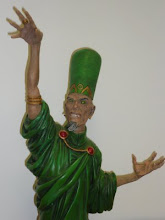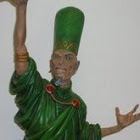A very entertaining and enjoyable comic about a wolf in sheepdog's clothing. The comic manages the set up for the story very cleverly before moving to the start of a major on-going storyline.
In the opening story
Good Cop Bad Cop , written by Jim Alexander, art by Gary McLaughlin and lettered Jim Campbell, the story gets off to a nicely savage start. Detective Inspector Brian Fisher is interviewing a suspect in a dismemberment case when the interview goes horribly wrong, just not as horribly wrong as it will do for the suspect. This economical story introduces the two lead characters without stopping for any unnecessary explanations, the events just occur. This is the first of a series of very clever moves Jim Alexander makes to deal with serious structural problems that come directly from the story idea. The bad cop is simply presented as an established fact, the reader is taken off on the ride without further ado.
The next story
Mrs MacPhellimey, written by Jim Alexander, art by Gary McLaughlin, and lettered Jim Campbell is a neat, short joke that showcases the pitch black humour that laces the comic. The change in tone from the first story is nice.
Three Strikes written by Jim Alexander, art by Gary McLaughlin, and lettered Jim Campbell is the next step Jim Alexander takes in turning structural problems into advantages and story possibilities. Detective Inspector Brian Fisher is a dedicated police officer who is also a massively violent and predatory and physically distinctive murderer with a police warrant card. A key storytelling problem is how the tension between the two is managed and this is resolved in a unexpected and very clever way.
Under Investigation written by Jim Alexander, art by Will Pickering and lettered Jim Campbell resolves the last and most serious structural problem arising from the story idea. Given that the police force are reasonably competent the extreme actions by one of their officers is bound to draw the attention of the senior ranks. They way that it does and how Jim Alexander uses that to create credible story telling possibilities is a joy to see. Smart writing and all done without ever sacrificing any action or without having to make the cast too stupid to be interesting. Indeed it is the fact that the senior policemen are not stupid is the key is a pleasure.
Between the three stories are pages from a crime report about the Partick Cat, a burglar that Detective Inspector Brian Fisher is pursuing. The report is written by Brian Fisher and the wolf and this performs a vital function for the story start up. The wolf is a savage predator, what the report conveys is the necessary view of the inside of his head and the realisation of just how dangerous he really is. A barely contained mix of rage, hatred and appetite for violence, the balance struck in Three Strikes looks like a very fragile bargain.
The set up complete a major on-going story line starts with
Tiny Acts of Kindness written by Jim Alexander, art by Luke Cooper lettered Jim Campbell. The change in art style is pronounced and effectively marks the departure of the story into the main event. The black humour get used to great effect and the balance between the Brian Fisher and the wolf, the relationship between then is used to drive the story. A suitably ferocious villain is also introduced, someone who would be a more credible opponent for the wolf.
The black and white art for the set up stories by Gary McLaughlin and Will Pickering is lovely line work with minimal use of shading or blocks of colour. The cast, including the wolf are vivid and forceful, the stores have a lean and spare feel to them. Luke Cooper's art is much denser, his use of black is astonishing to give form and solidity as well as express the black tones of the writing. The art gives the longer story greater weight which is a considerable benefit.
Clever, confident writing, great art and fresh heart in an intriguing idea all make for an great read.
Chief Wizard Note: This is a review copy of Good Cop Bad Cop very kindly sent by Jim Alexander. GoodCopBadCop Casebook#1 retails for £7.99/$12.99. Rough Cut will be launching the book at Plan B in Glasgow
Fri 24th Jan and Asylum in Aberdeen
Sat 25th Jan. The trade will be available in all good comic shops thereafter. Also available through Amazon and the Rough Cut shop (
http://www.roughcut-comics.com/). For more details contact
eddie.parade@virgin.net
 The title is wonderfully true in this spiky and joyously opinionated and very short book. Calling it a history of England is a very considerable stretch, it is a review of a partial list the kings and queens of England from Henry the 4th to Charles the 1st. The reason for writing the book is declared to ". ..being to prove the innocence of the Queen if Scotland,...and to abuse Elizabeth..." and this intention is pursued faithfully with a glorious disregard for anything other than the writers unvarnished and unsupported opinion.
The title is wonderfully true in this spiky and joyously opinionated and very short book. Calling it a history of England is a very considerable stretch, it is a review of a partial list the kings and queens of England from Henry the 4th to Charles the 1st. The reason for writing the book is declared to ". ..being to prove the innocence of the Queen if Scotland,...and to abuse Elizabeth..." and this intention is pursued faithfully with a glorious disregard for anything other than the writers unvarnished and unsupported opinion.



